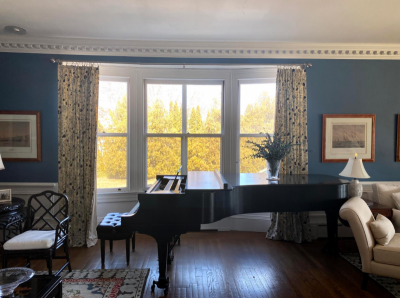Marion House makes the National Registry of Historic Places
Marion author, historian and Sippican Historical Society member Judy Rosbe and her husband Bob are proud stewards of their grand Gilded Age home, the H.R. Reed House, located at 46 Water Street, which made the National Registry of Historic Places in December 2019.
Once the summer home of sugar broker and investor Henry Ransford Reed, it was designed by Boston architect James Templeton Kelley and built in 1893. However, parts of the home date back to a smaller 1840s home on the property. That original home once attracted Mrs. Grover Cleveland and President Cleveland, who stayed there in the summers of 1887 to 1890 according to the National Register of Historic Places application.
Here Rosbe discusses the journey to getting the home on the National Register. The home qualified on the basis of both its historical significance and shingle-style build. It is the first house in Marion to be listed and the second structure. Bird Island Lighthouse was listed when all the Federal Lighthouses were listed at one time.
Sippican Week: How long have you owned this house? What is your history with it?
Judy Rosbe: We bought this home in 1986. We were living a few blocks away from here...I was kind of having trouble sleeping, so my husband and I would take long walks in the evening. And since we lived nearby, we’d walk down Water Street.
I always thought that this house kind of spoke to me... It came on the market, and I said ‘Oh, let’s go look, let’s go look!’ And before we knew it we owned it!
SW: What is it about this house that makes it so appealing to you?
JR: It just really appealed to me that this had a massive kind of scale to it, and also the detailing of the center entrance, the front hall, the center entrance stairway and the massive fireplaces...I was a history major in college and I seemed to be drawn to historical things.
SW: What sparked your desire to put the house on the National Register of Historic Places?
JR: We have a lot of very, very old historical houses. And we realized that we were one of the few towns...that doesn’t have a demolition delay bylaw, so a person can come and demolish a house without giving any notice from anybody, they just get a certificate from the town. We at the historical society, along with one of the selectman, Norm Hills who was very interested in it, cobbled together a demolition delay bylaw… [we] presented it at town meeting two years ago and it was resoundingly voted down.
[Being on the National Register] doesn’t restrict you in any ways, in fact we could tear it down if we wanted to, but I just felt that having that plaque on the front would deter somebody….It gives it some honor.
SW: What was the application process like?
JR: The historical society had an architectural consultant do a survey of historical buildings in town...we had a good portion of it done in 1998, and [it] was suggested that [this house] either be put in a historic district or made it into a listing for the National Register. So I wrote to the Massachusetts Historical Commission...I took a bunch of pictures of the outside and also the inside. They looked at those and they said, ‘Yes, it would qualify.’
They told me I could fill out the forms myself but nobody ever has done that and been successful at it. So they gave me a list of people and organizations that would be qualified to fill out the forms for me. I called up a friend of mine in town who is very active at the Boston Public Library and knew people in Boston and went down the list with her and she said, ‘Oh, Claire Dempsey is really good, you should hire her…’
She did a fabulous job. [She went] to the Plymouth County Registry of Deeds, to the town hall to see all the assessments all the way back and what changes are made. And she’s the one that really wrote [the application] up. She also took photos but they used a lot of my photos too in the application.
SW: How long did the process take?
JR: They said it would take two years but the Historical Commission was hiring new people and they were kind of in a state of flux and it actually took three and a half years from start to finish.
SW: Anything else you’d like me to mention?
JR: I’m just hoping that others might be inspired to get their houses on the National Register too. It’s an interesting process actually, I learned a lot about the house.
This interview has been edited and condensed for clarity.























